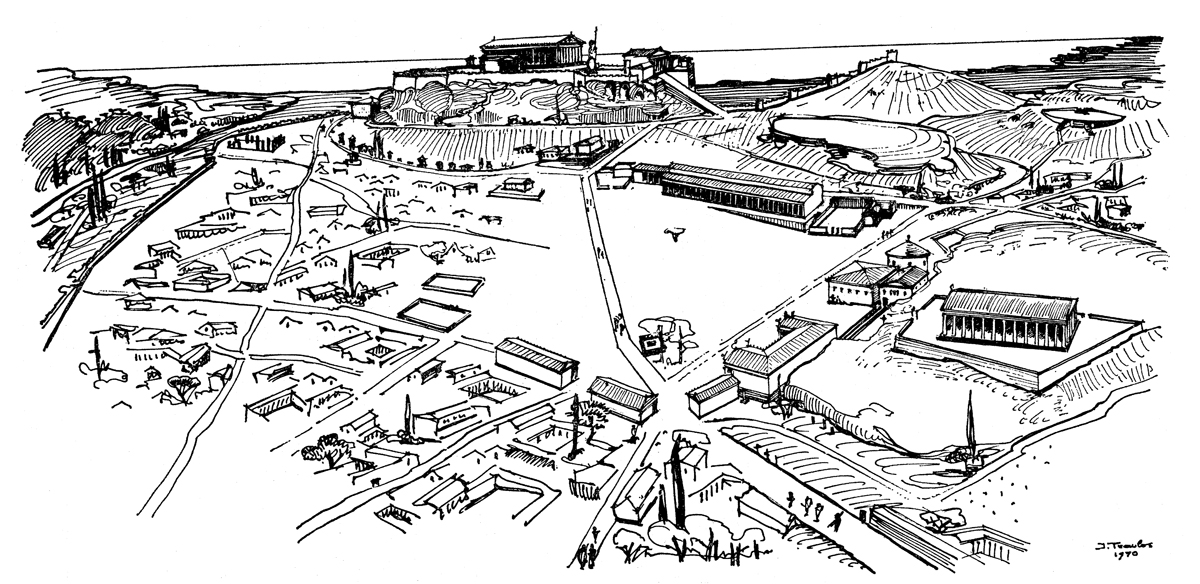Public space and private commerce?
The agora in Archaic Greece is defined as space of public exchange, assembly, political and religious manifestation. In his research project (B-3-8) Oikonomia and Agora Peter Spahn will investigate when and how the agora developed into a marketplace and what influence it had on economy and society. His working hypothesis is that the market and the increasing use of coins, which was also politically conditioned, largely determined the literary discourse on oikonomia. Alongside the oikos (household), the agora became another important place for oikonomia in the Greek polis, although not at first. Until the 5th century BCE the agora served primarily political functions and also as a space for the cults of gods and heroes as well as for agons (contests) and festivals. It is not known whether the place had already begun to serve an economic function as a marketplace in the archaic town (polis).
It is only beginning in the time of Perikles (century 495-429 BCE) that literary information on this subject begins to accumulate, mainly in the writings of Herodotus and Aristophanes. There is some evidence that the economic role of the agora, particularly in Athens, was an innovation that raised many new questions. For the abovementioned reasons, Athens plays a decisive role in the ongoing investigation. Apart from literary sources there is also rich archeological evidence from excavation campaigns. On the one hand the number of literary sources describing the situation in Athens makes this investigation particularly promising. On the other, Athens also serves as a backdrop when it comes to distinguish whether certain aspects can be considered as typical of the Greek polis during the period in question or described as specifically Athenian.
 Herodotus describes the role of the agora as a place of trade as something typically Greek. According to him, the Persians used no marketplaces at all. In Aristophanes’ comedies, the agora figures as the place where contentious political, social, economic and ethical problems intermingled and came to light: the democracy of the demagogues, the despised classes of retail traders and artisans, the monetary economy and the disintegration of dike (justice) and nomos (manners, convention, order, law). Following the outbreak of the Peloponnesian war, food in Athens was predominantly supplied in the agora, in contrast to the traditional economy of a rural oikos; a special term was even coined for this phenomenon: “attike oikonomia”. Obviously the agora by this time had become the opposite of traditional economy, especially with the use of coins that seemed strange and disagreeable to the rural citizens.
Herodotus describes the role of the agora as a place of trade as something typically Greek. According to him, the Persians used no marketplaces at all. In Aristophanes’ comedies, the agora figures as the place where contentious political, social, economic and ethical problems intermingled and came to light: the democracy of the demagogues, the despised classes of retail traders and artisans, the monetary economy and the disintegration of dike (justice) and nomos (manners, convention, order, law). Following the outbreak of the Peloponnesian war, food in Athens was predominantly supplied in the agora, in contrast to the traditional economy of a rural oikos; a special term was even coined for this phenomenon: “attike oikonomia”. Obviously the agora by this time had become the opposite of traditional economy, especially with the use of coins that seemed strange and disagreeable to the rural citizens.
The connection between polis, oikos and oikonomia among the Greeks is clear and has been well researched for the most part. Nevertheless Peter Spahn aims at drawing attention to the question to what extent the Greeks differ in this area from other early societies, particularly from their oriental neighbors and ancestors. Another aspect will be topography: changing or shifting functions from one to another part of the agora, the motivations for a new division of space highlight the complex function of the agora and will reveal the political and social structure of the Greek polis in general.
RELATED LINKS
Event: Oikonomia and Chrematistike
Research project: (B-3-8) Oikonomia and Agora
Read more articles in TOPOI FEATURE
CREDITS
Image above: The Agora from northwest, middle of 4th century BCE | Author: Illustration by J. Travlos | Source: H.A. Thompson and R. E. Wycherley, The Agora of Athens: The History, Shape and Uses of an Ancient City Center, The American School of Classical Studies at Athens: 1972 | © The American School of Classical Studies at Athens
Image central: Silver Tetradrachm of Athens 454-415 BCE | Copyright: Public Domain

